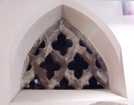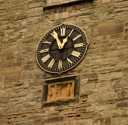For this church:    |
|
 Detail above the organ Detail above the organ |
The church comprised a chancel, which was built first, followed by a nave which was higher than the chancel. The nave had three bays and a tower. On either side of the carved altar are carved heads, believed to be those of King Edward III and Queen Phillipa. To the left of the high altar is an Easter Sepulcre, one of only three surviving in the county (the others being at Hawton and Sibthorpe). Subsequently, two more bays were added to the west end of the nave, and side aisles were also built, the southern one being dedicated to Saint Katherine. Above the alcove where the organ is situated, on the left side of the chancel, is a fragment of tracery which was hewn out of one piece of stone, and which must have been a three-light window head in the original fourteen century building.
In 1400 the Crown granted the rectory of the church to St Mary’s Leicester, and a priest (name unknown) was ordained as vicar in 1408. An early gift of vestments and twenty shillings was made by Robert Glade in 1423.
The first parish register is dated 1544: a Latin inscription on the front cover says: ‘This little book albeit small, contains the round of life – marriage, baptism and burial.’ The first entry is of the baptism of Richard Deverill on 20th November 1544.
 Carved panel Carved panel(below the clock face) on the south tower wall |
A new tower was built around 1550, the original one having been demolished when the two new bays were added. To the right of the high altar is a double piscina, and in Saint Katherine’s chapel there is a single piscina. In the pillar to the left of Saint Katherine’s altar is a small door which leads to a circular stone staircase which would have led to the original stone rood screen: the doorway at the top is now blocked by an imitation door, which is clearly visible high up on the south wall of the chancel arch. High up on the south wall of the tower is a carved stone panel, now badly weathered, which seems to represent the Annunciation of the Blessed Virgin.
In 1566 the Vicar (Will Grene) was suspended for giving Holy Communion to an excommunicant. In 1600 R Machell, H Suger and J Wright were reported for ‘mowinge upon a Sundaye at evening prayer’ and W Alvey for ‘sending his folks to gather crabbes (apples) on the Sabbath day’.
Two Arnold men were fined: Robert Lowns declared the new religion ‘Nothing but the old Christ in the Pope’s tyme’ and Robert Tasey ‘scoffed and mocked the new catechism, Articles of Faith and offered to say prayers for others’. They were each fined 6d to the Poor Box.
In 1601 it was reported that successive incumbents had failed to keep the chancel in good repair. This led to an enquiry, but the result has not survived.
Between 1610 and 1641 a number of Arnold inhabitants were recorded as Papist recusants.
The upper part of the tower was added in 1631, when a second bell was installed.
There is a local tradition that a cannon ball fired by Cromwell from Bestwood Park is lodged in the north wall of the church tower. It is actually the end of a rounded support.
On 14 August 1650 an Inquisition was held at the Shire Hall into the living of Arnold church because a Peter Fullwood, the preaching minister, who may have been a nonconformist, had continued to receive the tithes after his marriage to the grand-daughter of Sir Francis Willoughby.
After the Restoration of the monarchy in 1660, some local families of means refused to pay tithes or attend church, and there was no minister or schoolmaster in residence.
In 1685 the vestry used money to defray charges in setting the poor to work.
Towards the end of the 18th century Arnold became a significant area of framework knitting and other textiles, and in 1788 there was much industrial unrest, culminating in the destruction of a five-storied mill at Daybrook. In the 1790s Robert Davison and John Hawksley built a new mill at Arnot Hill, Daybrook, one of the largest in the country, employing nearly 700 apprentices. In the early 19th century two managers at the mill, William Huddlestone and George Wall) brought Methodism to Arnold.
Arnold was enclosed in 1789, and the churchyard wall was rebuilt in 1799. In 1819 the parish vestry refused to make up framework knitters’ wages.
There was excitement during a service in 1822, when a man called Piggins came intoxicated to church with a sledge hammer and had to be taken into custody.
The church was in decline during the first half of the nineteenth century, no doubt due to the growing popularity of Methodism. In 1835, the population of Arnold was about 4,000, but there was considerable difficulty getting people to take on the duties of churchwarden. Several disputes were recorded, one concerning plans to change the Feast date of the church. Pew letting was introduced in 1836, to try to raise some funds. In 1838 the vestry and church gallery were improved, and there were further extensive alterations in 1840. Chartism was very active in Nottingham in the 1840s and over 700 attended a service in Arnold in 1842 ‘with great decorum and attention’.
In 1851 the churchyard was enlarged.
In the religious census of 1851 the parish of Arnold was recorded as being an area of 4,670 acres, with a population of 2,426 males, 2,278 females, totalling 4,704. St Mary’s church was endowed with tithes of £220 and a glebe of £110. Inside there were 200 free places, plus 500 others, making a total capacity of 700. The congregation on Census Sunday comprised 350 in the morning service plus 180 Sunday Scholars, and 350 at Evensong with 180 Sunday scholars – totalling a suspiciously similar 530 for each service. No afternoon services were held. The entry was provided by George Atkinson, resident Curate.
The Rev George Francis Holcombe was vicar for sixty years, 1812-1872. He was a rich and powerful squarson, who lived at Sherwood Lodge and spent as much time as a magistrate as he did as vicar. He opened a church school for Arnold in 1845 and subsequently he was instrumental in organising an educational charity to support young people from families too poor to pay for education. The ‘Arnold Parochial Charities’ still provides bursaries for young people and for schools in Arnold with money accrued from investments of land which Holcombe first established.
Also in the 19th century, the Parish Clerk best remembered at Arnold was Thomas ‘Clerk’ Redgate, who served for 60 years in that role. He was remembered for conducting the responses at a desk under the pulpit with considerable dignity, wearing knee breeches, white stockings, and low shoes with buckles. He would march down the aisle and up to the singing gallery to join the choir, and there having drawn a bow across the bass viol, he announced in a very deliberate voice ‘Let us sing to the praise and glory of God, hymn …’. He would then conduct the instruments. He died on 20 June 1860, aged 86. His unmarried daughters lived in a small house adjoining the steps entering the churchyard, and they were responsible for cleaning the church. The last surviving daughter, Sarah, died in 1910 aged 93.
While Holcombe was Vicar from 1812-1872, his curate between 1833 and 1838 was the Rev William Howard. He was concerned with welfare, held a school for young gentlemen and a Sunday School for over 300 children. On Monday evenings his daughter and others taught reading, writing and arithmetic. He died in 1873, then Vicar of St John’s, Nottingham.
The village petitioned Parliament in 1853 for an inquiry into the state of the village, but the vicar declined to attend. This led to the formation of the Local Board, which gradually took over the running of the village.
In 1865 the church was in a dilapidated state, and the cost of repairs was estimated to be £2,800. Only part of the work was carried out, and the church was closed for two years. A lawsuit followed, as the Vicar had ordered changes to the plans, with a trial and arbitration, and a second firm of contractors finished the work at a cost of £4,000 including legal costs. £700 had to be borrowed from the Commissioners of Public Works over a 20 year period. The rest of the money came from subscriptions – the Duke of Devonshire provided £1,500, the Vicar £400, Mr S Morley £100 plus a few others. This compulsory church rate to repay the 20 year debt was unpopular, and there was dissatisfaction among the parishioners at the way the work had been arranged. There was contested polling over two days, the number of votes allowed for each voter depending on how much they were assessed as able to pay. The poll was taken on 7 and 8 February 1867, and 56 ratepayers gave 129 votes for the loan, 111 gave 138 votes against. 36 occupiers of cottages or garden holders claimed to vote, but were refused as they were compound householders. 58 ratepayers holding 76 votes did not vote. Compulsory church rates were abolished by Parliament in 1868.
In 1866 the Industrial Exhibition was held in Nottingham and they requested the use of the National School to interest workmen in making articles of skill to exhibit there. Holcombe said that he could not grant the use of the National School for any purpose other than that of education, and that he did not approve of meetings in Arnold ‘well knowing that at present the inhabitants are not sufficiently intellectual for such assemblages’.
The chancel was restored in 1877, and the font was dedicated in 1899, when a lectern, new heating system and baptistry were added. Sir Charles Seely provided the money for the coal-fired heating system, which was converted to gas in 1959.
In 1911 there were 330 children on the Sunday School roll. There were 94 baptisms and 30 confirmations in the year to 30 September 1912.
The parochial church meeting and vestry meetings were joined in 1922, and by 1925 the Easter vestry meeting had died out.
A new chancel screen was erected in 1924, the gift of Colonel Frank Seely. As part of his gift he donated new choir stalls, a marble pavement in the sanctuary and the reredos for the high altar.
The tower was restored in 1928 and in 1930 a new porch was erected on the south door by Dame Eveline Maude Robinson, in memory of her husband, Sir John Robinson, who founded a brewery and laundry which employed local people. He had been born very near to the church.
The roof was damaged during Second World War and an appeal for £3,000 was made.
A seam of coal was found under the church, and so extensive repairs were made culminating in the church being placed on a ferro-concrete raft by the National Coal Board. The church was closed from 12 January 1958 while the coal was dug out and the underpinning and raft took place. At the same time a new roof was constructed and the building restored and decorated. It was re-consecrated on 8 February 1959. The fourteen corbels which supported the original roof are still visible high up on the walls of the nave. Gas central heating was also installed and the building was decorated. While the work was being done, the NCB provided a temporary wooden building in the church grounds for services. The old Victorian vicarage was also demolished and a new house constructed.
The Family Centre, the community church hall, was opened in 1965 on the old vicarage site.






